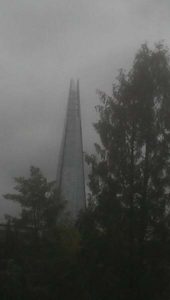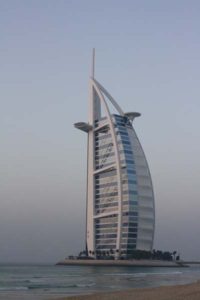o2 June 2016
The Politics of Concrete
What do our towers tell us?
by J.R.Thomas
 It has been a good year for aficionados of John le Carre. A biography of him came out in paperback; his novel “The Night Manager” was made into a six part series by the BBC (no expense spared) and was hugely acclaimed; and last week another adaption of a novel of his, “Our Kind of Traitor”, hit the big screen.
It has been a good year for aficionados of John le Carre. A biography of him came out in paperback; his novel “The Night Manager” was made into a six part series by the BBC (no expense spared) and was hugely acclaimed; and last week another adaption of a novel of his, “Our Kind of Traitor”, hit the big screen.
Mr Le Carre is a man of many contradictions – for reasons that his biographer, Adam Sisman explains in the surgically detailed account of his life. In real life David Cornwell, he is a private man with a mysterious and often contradictory backstory, but one thing is clear; unlike most of us, he has become more left wing and more radical as he has got older.
Our Kind of Traitor was written in 2010, vintage Le Carre displaying his increasing anger at the way we live now, attacking the tendency of the British establishment to deal within a charmed circle and solve problems privately. Where his novels used to explore human frailty and deceit in a fictionalised Secret Service (which was, and probably still is, much like the real one) his radicalisation has moved him to explore, or maybe create, uncomfortable links between money, Western capitalism, and politicians.
“Our Kind of Traitor” is not Le Carre’s usual style of film. Seen through his viewfinder, the gloomy, almost seedy, world of Smiley and Karla and Bill Hayden has become more glossy and stylised. Much symbolism is used to indicate the nature of the various protagonists and their world. The baddies drive (of course) black Range Rovers with smoked windows – this is becoming such a cliché incidentally that one wonders why the police do not simply do their work by arresting on sight all passengers in every black Range Rover. Switzerland here consists of luxurious hotels with conference rooms guarded by uptight but fawning flunkies, and the numerous half shaven Russian mafia types must constantly sluice from their laps the willowy stocking clad beauties who accompany them everywhere. And, we notice, and finally we reach the raison d’etre of this musing, that the world of dirty money and evil financial machinations, in short, the City of London, is now represented by the Shard. The Bank of England used to do that job quite adequately, but was then replaced by the Gherkin. Not for long, something taller and more symbolic and suitably chillingly arrogant appeared; the Shard has the job.

One can see why. This enigmatic elongated pyramid of steel and glass, resembling nothing so much as a sliver of polished ice aimed at the heart of all that is kind and hard-working and honest, is too good a metaphor to resist for the way in which the City supposedly sticks its rapier point into all of us. There are several flaws in this symbolism. For a start the Shard is not in the City of London at all, but in the slightly more gritty London Borough of Southwark, on top of London Bridge Railway Station. And it contains very few City type occupiers – it is partly an hotel, partly residential apartments, partly offices. The most famous office tenant is Al‑Jazeera Media, the Middle Eastern TV news network, who scoot across the polished marble lobby avoiding such other evil capitalists as a PR agency, Campari, a gas importer, and, it is true, a stockbroker or two.
So as a symbol of rapacious international finance it does not quite fit the bill. In fact, says film maker and observer of urban life, Tom Wolseley, it does not fit the bill at all. That the Shard, and towering buildings generally, are not about domineering capitalism, is the message of the film “Vertical Horizons” which he is currently making. Film makers do have a bit of a thing about very high buildings (as admittedly, does this columnist). Those who have seen “High Rise” (Reviewed by the Shaw Sheet on 24th March) may have also have winced their way through Ben Wheatley’s depiction of the collapse of society as organised over forty floors of a 1970’s residential tower block. Wolseley and Wheatley seem to agree on one thing at least – tower blocks are about much more interesting things than making money.
Wolseley spelt this out in a lecture, Shardology, at the University Of London last week, part of its one week Festival of Culture programme. Whilst showing rushes of his new film – rushes is not quite the right word, as the film consists of quiet intense observation of the Shard from a revolving camera stationed at various points in London – Wolseley talked about towers and why we build them, and the effect they have on us. Any symbolic representation of capitalism is incidental, he says. As a means of making money they are ill-conceived. He pointed out, delicately, that the Shard was so long delayed in construction and so expensive to build that the original developer has been unable to retain ownership; also that towers often fail financially, are expensive to operate and maintain, and do not command the premium rents and sales values which make the extra cost of all that verticalism worthwhile.

So, why do they get built? Why is Shanghai a forest of high-rises? What reason would Dubai, a land of endless useless sandy wastes, have for building upwards on a tiny little strip by the sea? New York admittedly had the constraints of Manhattan island, but the municipal engineers learned long ago how to bridge (and tunnel) that gap; yet still the towers crowd on the southern tip of the place. And dear old London, capital of the land of the terrace and semi, now has its every sylvan grove spotted by towers. Wolseley’s answer is simple – politics. Towers are symbols of political power, of aspiration by rising nations and resistance to decline by mature ones. It says, we can build bigger and higher than you lot in the West, or in the Gulf, or on the Bund. It says, this is where the future is; look at our high-rises and despair. Worse still – towers also, he says, signal a rebirth of deference, an erosion of democracy, symbols of authority as we the people increasingly give up our rights to participate in the world around us.
It may be capitalism that finances the endless concrete and the polished steel and the triple gazed windows, the express lifts and the triple height foyers, but it is our political masters who drive the towers up and up, and up. The planning system helps this to happen, not just through planning and zoning, but also by public transport systems, by restrictions on urban sprawl, by environmentalism which says that higher is greener (it isn’t). In Shanghai and Dubai the governments are able to drive this process directly. In London and New York and other high rise cities of the democratic West, the process is more subtle – but not much more subtle. The City of London had plot ratio rules which, when combined with restrictions on light and movement, meant that towers were the only way to fit a development on the base land. The legend goes that the NatWest Tower (now less well known as Tower 42) was intended to be a fat seven floors but that land use restrictions forced it to a pencil slim forty two stories. Later the plot ratio was abandoned – but not its spirit. The City Planning Officer, when shown the original drawings for the Gherkin, said that it had to go much higher. It did.
Wolseley is glum about what our towers say about the spirit of Europe. Whilst Far Eastern and Middle Eastern towers soar, London’s towers are pretty pathetic – not tall enough to show any serious competition – but at the same time symbols of the citizens’ loss of control in a free society. If towers are our peacock tails, in Britain they symbolise that we can’t get them properly up, let alone dazzle with them; yet still we dash about under their foreboding windswept gloom. And in Europe there are hardly any serious towers at all. Now there’s a thought for Leavers and Remainers to debate.
If you enjoyed this article please share it using the buttons above.
Please click here if you would like a weekly email on publication of the Shaw Sheet

